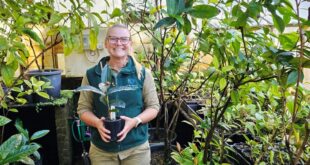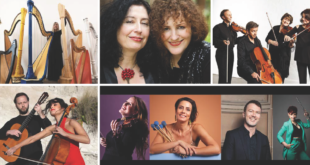
Manda Kaye and Julie Paterson at their home in Blackheath.
Story and photographs by Hamish Dunlop
Julie Paterson and Manda Kaye’s home in Blackheath was designed with bushfire in mind and they are now preparing for the bushfire season. They’ve also moved to renewables and Julie is working on collaborative community art projects that embody the philosophy of re-using and re-making.
Key Points:
- Julie and Manda’s Imperfect Manifesto speaks to a simple, creative life that is good for people’s health and the health of the planet.
- The philosophy of Julie’s business is to use every single scrap that she’s ever made in the manufacturing of products.
- Julie is demonstrating a culture of re-use, re-making and repair. She provides sewing kits in their Rough Track Cabins. The idea is that people can repair what they bring when they come to stay.
Share this article:
I’m racing down Evans Lookout Road in Blackheath on my bike. It’s barely spring and the temperature is in the mid-twenties. Not far after the Neates Glen car park, I turn right into Rough Track Cabins. Julie Paterson is standing in the front yard. She welcomes me with a smile and a generous hug. Julie and her partner Manda Kaye have owned the 11.7 ha property for six years.
Inside the house it’s delightfully cool. Julie tells me that the house was built by conservationists and landscape architects Ian and Sue Olson in the 1970s. The couple lived in a caravan during the build. There was no power on the site, so everything was hand cut which makes for soft geometries. All the internal walls are made of iron stone sourced from the property. I comment on the temperature and Julie says it’s primarily because of the stone’s ability to absorb, store and release heat.
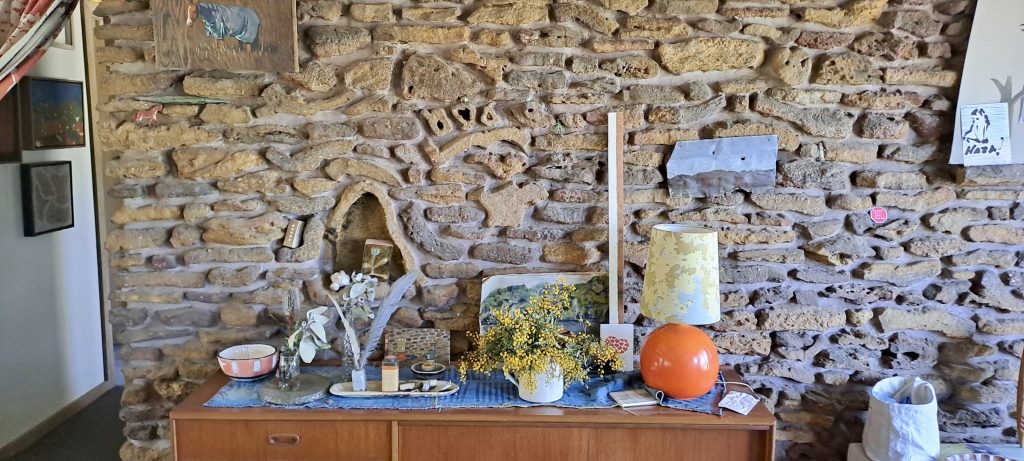
Internal iron stone wall.
The concrete floor combined with the iron stone means that the temperature is more-or-less constant throughout the year. The house is aligned east to west and large windows capture the warmth of the sun in the colder months. When the sun is higher in summer, the windows are obscured by the eves. The stone and concrete absorb warmth from the house and cross-breezes draw out the heat.
Preparing for fire

Sticks gathered ready for removal to reduce the fuel load near the house. Fire hose fed from the dam.
We head outside so Julie can show me the fire preparations she and Manda are making. Julie points to a bundle of sticks as we exit the house. “We’re gathering sticks and leaves and moving them away from the buildings.” There’s a box on the wall labelled ‘FIRE HOSE’. It’s a system the architect devised. He built a dam above the house that feeds the hoses using a petrol generator. The dam is edged with reeds and sedges and there is a cacophony of frogs. It’s a water resource for fire mitigation and a habitat for indigenous species.
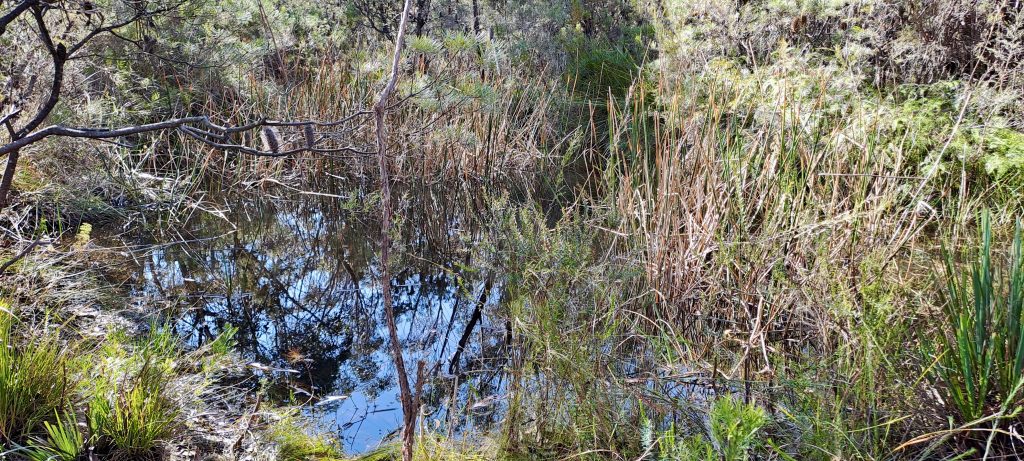
The dam above the house.
As well as removing the ground fuel load, Julie keeps the native grasses cut right back. There is a wide access track running around the property to facilitate firefighting. Julie and Manda hire local tree man Tim who comes with a ride-on slasher. Beyond the track he’s creating a buffer zone by removing much of the mid-low canopy species.
The ground is being cleared to reduce the chance of ladder fires that set the upper canopy alight, creating much hotter and more dangerous fires. Three quarters of the property is conservation zoned, so this aims to separate the denser bush from the areas around the buildings.

A section of the access track and the cleared buffer zone beyond it.
The house has survived three major bushfires. The last fire was in 2019/20. It came from the west crossing the Grose Valley. Julie remembers all the fire units in the driveway and the pink fire retardant being dropped by helicopter along Evans Lookout Road, stopping the fire front about 100m from the house.
Walking around the house towards the cabins Julie points to the track we’re on. It’s clay-heavy earth and the imprints of the slasher’s tracks are dried solid. “During the wet” Julie says, “water would run away from the house and flow over this garden. This was a total bog. Now at the beginning of spring its rock hard and we’re apprehensive about the fire season to come.”
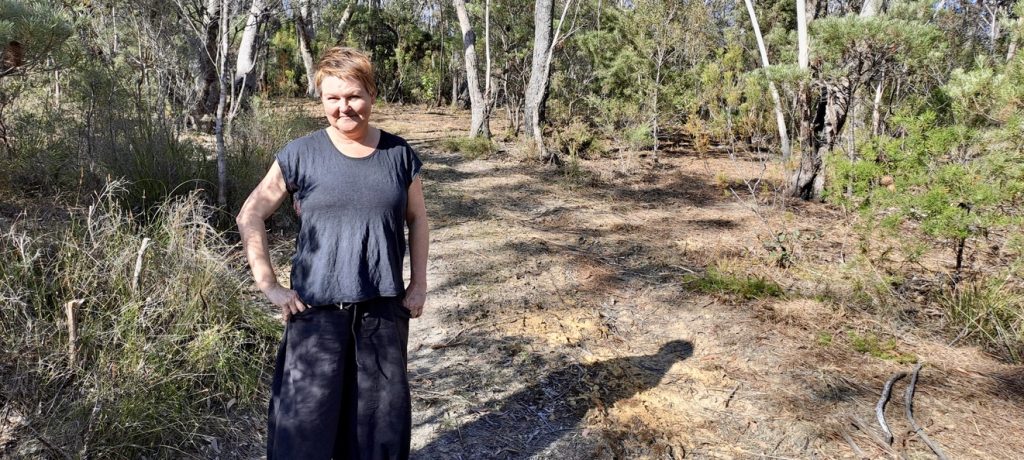
Julie on the dry path.
Switching to Renewables
There are two cabins on the property. Until recently, their amenities were run using gas cylinders. Julie and Manda have installed heat pump hot water systems and during the day electricity comes from solar panels on the roof of the main house. They have room to double the solar array and plans to install a battery system in the future. “We purchased the systems because they function well in the heat and the Mountains’ cold.”

Heat pump hot water system.
A Philosophy of Re-use and Re-making

Part of a curtain and lamp made by Julie.
Julie is a painter, printmaker and designer of textiles. Her core business is creating high quality, Australian manufactured upholstery and furnishing fabrics. All the fabrics are made from hemp and linen and printed in Wagga Wagga. She finds using virgin fabrics a juggling act. “I have a small business that uses new materials and I try as best I can to make that business circular and sustainable. I use the highest quality materials I can so they have a very long lifespan and am always looking to re-use and re-make.”

The Imperfect Manifesto on the wall of Manda’s studio.
Both her and Manda are focused on people and the environment. They wrote the Imperfect Manifesto that speaks to a simple, creative life that is good for people’s health and the health of the planet. While she produces screen printed fabrics, Julie also uses the offcuts the business creates to make other things. “The philosophy of my business is to use every single scrap that I’ve ever made in the manufacturing of products.”

Inside one of the cabins.
Inside the cabins there are patchwork curtains made from old sample books and vintage blankets and tiles she made and locally fired. Objects such as lampshades reveal the hands of the maker and the history of their materials. The fabrics are often drawn together with embroidery. Sometimes this looks like landscape features from above, or geometries that complement the printed organic forms. Words are also stitched in places. They speak whimsically of how humans and materials express each other and are poignant signposts to a way of being that’s in harmony with the world.

Chair back with Haiku poem.
Repair
Last year Julie had an exhibition at Shoalhaven Regional Gallery that explored the concept of repair. Objects that were well-worn had new life breathed into them. The show was well received and she considered touring it. What eventuated was closer to home – she recreated the exhibition in the cabins and aims to engage people in the process of repairing whilst they spend a few days relaxing: “I want to encourage people to treasure used things. To embrace the passage of time and how we live imperfectly.”
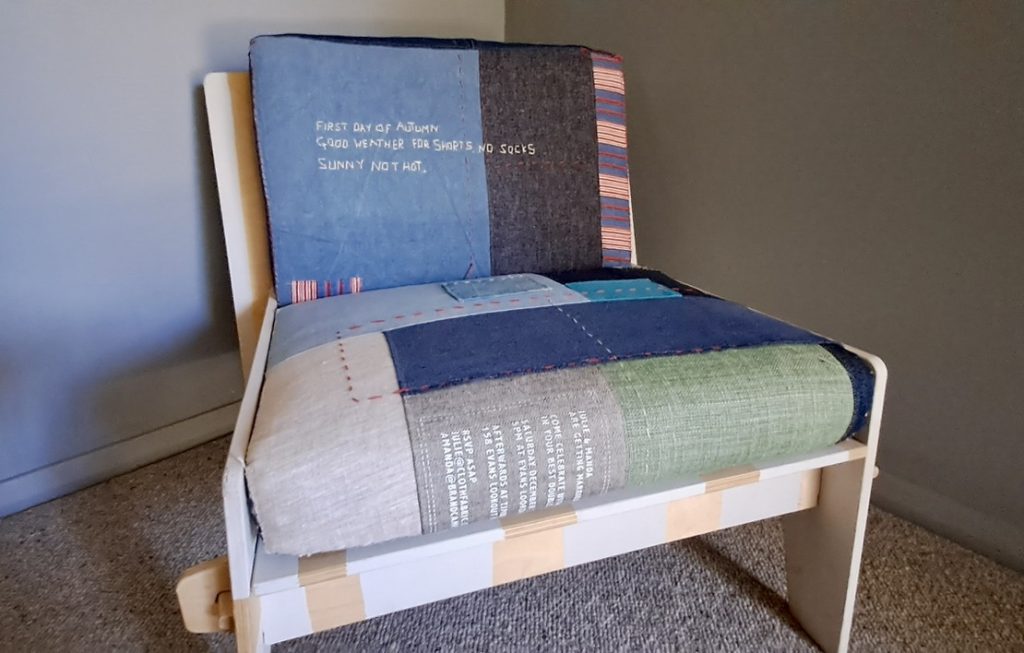
An old Ikea chair that was in the exhibition in Shoalhaven. Re-upholstered with recycled foam, fabric and stitched into life.
To do this Julie provides sewing kits in the cabins. The idea is that people can repair what they bring when they come to stay. The cabins are inspiration for this process. Julie says she also wants people to leave their own meditation on repair by embroidering a section of curtain. In this way, the cabins become a collaborative exhibition that grows and transforms over time.
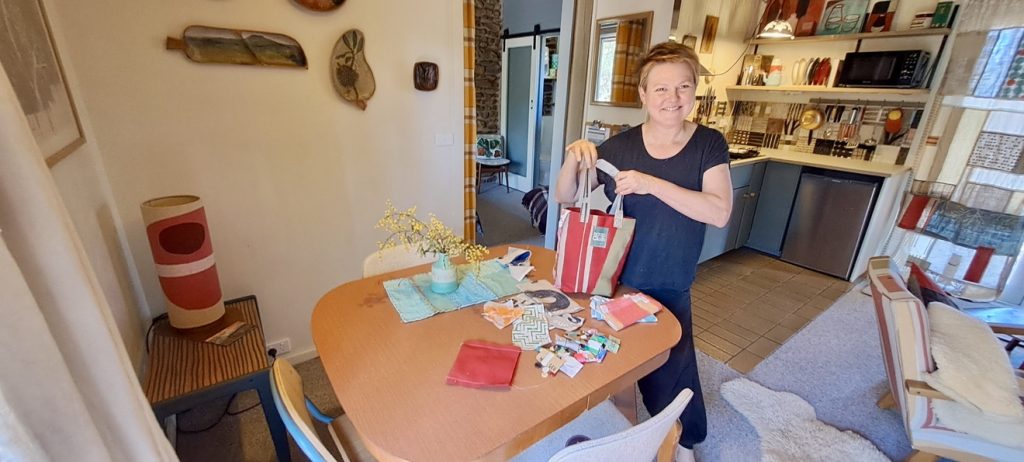
Julie with the sewing kits she has created.
Everybody Blankets
Guests can participate in the Everybody Blankets project too. Julie is going to leave bundles of wool in the cabins so that when people come to stay they can knit what she calls ‘those wonky squares.’ She’s putting a call out to the wider community. “Everyone knows that when you knit there’s always a little bit of wool left over. I’d like people to send me those pieces as a way of participating in the philosophy of reuse and community art – pure wool only though as we are really trying to minimise the use of synthetics in the cabins.” The squares will be stitched together into blankets and become part of the re-use and re-making life of the cabins.
Julie says she’s hoping for two blankets for each cabin for guests to use. If it’s successful, all subsequent blankets will be donated to charity.
Collaborative Creation
Julie recently had a second show about repair and the art of collaboration at the Embroiderers’ Guild in Sydney. Part of the show was to encourage people to send her a simple drawing of plants. The project was called Community Garden. She stencil-printed these designs and sent the fabric back to the participants: the gardeners as she calls them. “They can use the fabric to make something to live with. It could be lampshade or bag or be used to breathe new life into something well-used. I hope they embroider the fabric too. It’s another layer that adds to the richness of people’s creations.”

After noticing a stubborn tea stain on Manda’s mum’s favourite chair, rather than re-upholster it Julie chose to stitch around the stain. By doing this simple act of repair she was both honouring the history of the chair and the life of Margaret her mother-in-law: the person who loved to sit and drink her tea on that chair for many years.
Time for Tea
As Julie, Manda and I sip tea, the conversation turns to the state of the world and how we arrived here.
Julie talks about her mother and the amount of hair spray she used to use. “It was my joke,” she says. “We knew back in the 70s that we were doing significant harm to the planet. The hole in the ozone layer over New Zealand was a big thing when I was growing up in England. I was hyper-aware of it as a young person. Mum putting those ozone-damaging Chlorofluorocarbons (CFCs) into the atmosphere every day for the sake of a beehive type hairdo seemed excessive to me. But it was just what people did back then. Poor Mum. She got so much nagging from me. I’m pleased to say she doesn’t do it anymore. Wish the same could be said for the bigger polluters.”
Do Manda and Julie seem themselves as activists? Julie says “Manda is the one on the ground doing the hard stuff, reading the articles and writing the letters. I do it through my art practice. I show people how to enact change through everyday, creative actions.” It’s clear they are both invested in human and planetary health. Whether it’s ‘feet on the street’ or designing spaces for creative contemplation, they are living their values. “It all counts.” says Julie. “We can all make a difference.”
Take Action:
- Visit Julie’s website to learn more about Manda and Julie’s creative projects and to subscribe to their newsletter: https://www.juliepaterson.com.au/
Share this article:
This story has been produced as part of a Bioregional Collaboration for Planetary Health and is supported by the Disaster Risk Reduction Fund (DRRF). The DRRF is jointly funded by the Australian and New South Wales governments.
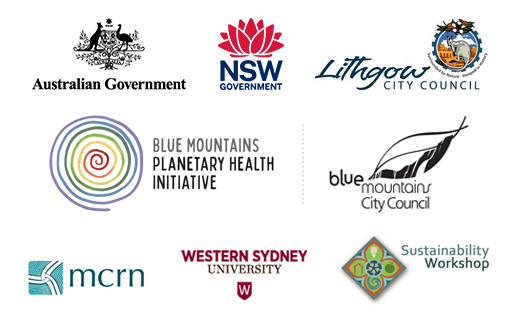
More from around the region
We are thrilled to announce that award-winning health writer and author Sophie Cousins will be leading the workshop: Our Community, Our Stories: Writing for Change from 2-5pm on Saturday 25 May at the Planetary Health Precinct. Sophie`s work has been published in the New York Times, London Review of Books, the Guardian, the Lancet, Meanjin and others. She also works as a public health consultant for the World Health Organisation. The workshop will be followed at 7pm by the launch of the Planetary Health Writers Network. Places are limited so bookings essential (link in profile): https://www.eventbrite.com.au/e/our-community-our-stories-writing-for-change-tickets-895548458547
#writingforchange #impactfulstories #solutionsjournalism #writingworkshop #planetaryhealth #changethestory #thenewsweneed #writersnetwork #bluemountains #katoomba
We`re thrilled to welcome Tamsyn McGrouther to our growing team of volunteer storytellers. She`s reporting on how the Springwood Lot Party transformed an underused space, the car park at Springwood Train Station, into a vibrant community space with food stalls, art opportunities and live music. Read more in Springwood Area Local News (link in profile) : https://springwoodlocalnews.com/springwood-lot-party-2024/
#changethestory #hyperlocalmedia #solutionsmedia #springwood #inspiringstories #planetaryhealth #bluemountains #localnewsmatters
What do tea, samurai clans, William McArthur, Benjamin Franklin, Vietnam and the Botanic Gardens at Mount Tomah have in common? Read our story in Blackheath Area Local News to explore the way camellias and cultures are woven together and why it’s important we think about conserving biodiversity as a global project implemented at a local level. (link in profile) https://blackheathnews.com/camellias-at-blue-mountains-botanical-garden/
@botanicsydney #botanicgardens #mountomahbotanicgardens #camellias #camelliasinensis #tea #samurai #bluemountains #themounts #biodiversity #planetaryhealth
Mushrooms are a hot topic at the moment with more and more research illuminating the essential role these organisms play in the health of the planet as well as the significant health and medicinal benefits they hold for humans. Belle Butler visited local mushroom grower, Alex Felix, at his farm in Lawson to talk about the mighty mushroom. Read more in Mid Mountains Local News (link in profile)
https://www.midmtnslocalnews.com/earthrising-mushroom-farm/
#mushroomgrowkit #mushrooms #fungi #growyourown #lawson #bluemountains
Mushrooms are a hot topic at the moment with more and more research illuminating the essential role these organisms play in the health of the planet as well as the significant health and medicinal benefits they hold for humans. Belle Butler visited local mushroom grower, Alex Felix, at his farm in Lawson to talk about the mighty mushroom. Read more in Mid Mountains Local News (link in profile):
https://www.midmtnslocalnews.com/earthrising-mushroom-farm/
#lawson #mushroomfarming #fungi #mushroomcompost #oystermushrooms #mushroomgrowkit #bluemountains
Maligned through the ages for their association with witchcraft, disease, drug use and poisonings, the fungus kingdom is gaining due credit thanks to ecologists, photographers and foragers. Read more in Katoomba Area Local News (link in profile):
https://www.katoombalocalnews.com/fungi-of-the-upper-blue-mountains/
#fungi #fungus #mycelium #fantasticfungi #bluemountains #planetaryhealth #katoomba #foraging #fungiforaging #fungiphotography #ecology
Yesterday we interviewed physicist Emeritus Professor Hans Coster at Middle Earth in Lithgow. He was in charge of the Sydney Chapter of the Club of Rome and we can`t wait to share with you everything we learnt when we visited him in the home he`s built into a hill in Lithgow. Subscribe to our newsletter via any of our news sites to make sure you get this story! Link in profile.
#nickelironbatteries #middleearth #planetaryhealth #hanscoster
Inspiring reading and a video of Harry Laing`s mesmerising performance of `Time of Fire` in the Blue Mountains Planetary Health newsletter (link in profile): https://bit.ly/3UyytbE
Subscribe to receive this fortnightly via any of our news sites:
Katoomba Area Local News: Fungi of the Upper Blue Mountains
Mid Mountains Local News: The Fun Guy: Earth Rising Mushroom Farm in Lawson
Blackheath Area Local News: A Carnival of Camellias: Beauty and Biodiversity at the Blue Mountains Botanic Garden
Springwood Area Local News: Springwood Lot Party: Transforming an Underused Space Into a Vibrant Community Event
Lower Mountains Local News: Women Helping Women to Survive and Thrive
Lithgow Local News: Fabulous Fungi in Lithgow & the Blue Mountains
@botanicsydney @zontaclubbluemountains
#fungi #fantasticfungi #camellias #zonta #camelliasinensis #springwood #harrylaing #timeoffire
With a bit of tweaking we can reduce how much we need to spend on water and energy. Blue Mountains libraries now stock free-to-borrow ‘My Energy and Water Saver’ kits that Blue Mountains residents can use to assess their homes for energy and water efficiency. Belle Butler borrowed one of the kits and discovered some room for improvement in her Lawson home. Read more in Mid Mountains Local News (link in profile) https://www.midmtnslocalnews.com/saving-power-with-take-home-kits/
@bluemountainscitycouncil
#energyefficiency #waterefficiency #savemoney #savetheearth #freeresource #librariesrock #takeaction #planetaryhealth
Blackheath Public School is providing hands-in-the-dirt lessons on how students can make their school more sustainable. From Crunch & Sip to Cluckingham Palace – literally! – organic waste makes the sunflowers shine and worms frolic in the fertile compost. Students will soon be eating spinach and cheese scrolls made by the canteen using garden produce, while parents report their children want to eat more vegetables. Read more in Blackheath Area Local News (link in profile): https://blackheathnews.com/sustainability-at-school/
blackheathpublic_pandc #blackheathpublicschool #blackeath #bluemountains #sustainableschools #schoolgardens #schoolgardensmatter #planetaryhealth
A fun day yesterday for @bluemountainsplanetaryhealth! In the morning we interviewed and filmed the young people in our Upcycling Fashion Skillshare program. They`re helping create the circular economy we need. In the afternoon we ran a workshop on media skills to help another group of young people learn how to create the news we need, and the news they want to see! They learnt how to use green screen and teleprompter technology as well as skills for interviewing and presenting the news. We`re looking forward to sharing the outcomes! Thank you @heli.jones @kalanigacon @kfmmedia #solutionsmedia #thenewsweneed #upcyclingfashion #planetaryhealth #skillshare #katoomba #bluemountains #pluriversity
Such a fabulous day working with a great bunch of young people to learn how news is made, how green screens work and how to create the news we all need to hear. We can`t wait to see the end result!
#solutionsmedia #thefixingnews #thenewsweneedtohear #greenscreens #mediaproduction #planetaryhealth #skillshare


